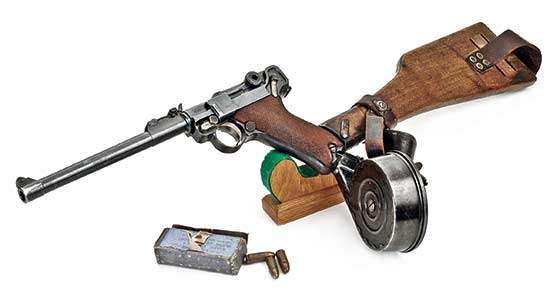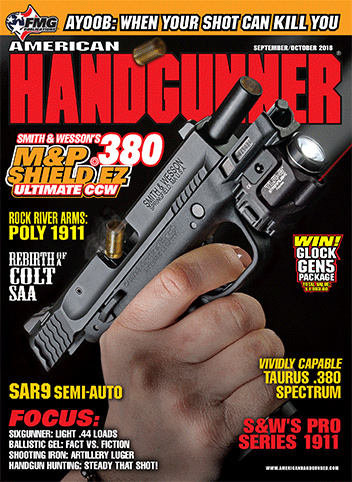WWI Handguns
The Artillery Luger
Being as how we’re around the centennial of America’s involvement in World War I, his Editorship Roy gave me the go ahead to cover some combat handguns used in The Great War.
First off let me say the word “combat” deserves emphasis. I’ll say up front it’s likely handguns saw much more combat in World War I than any significant conflict since. That’s because so much fighting in the intervals between huge battles involved close quarters such as trench raids for prisoners. Oral histories sometimes mention going on such endeavors armed with only handguns and grenades.
Germany often led firearms innovations among European nations. Their military developed advanced spitzer bullets circa 1905 and pioneered the concept of handguns convertible into carbines. It started with the Mauser “Broomhandle” C96 in both 7.63x25mm and 9x19mm Parabellum, and reached its zenith with the Model 1914 — aka the Pistole ’08 Long. These are “Artillery Lugers” in collectors’ terminology.
Going Long
The name “Luger” is almost as much a household word in this country as is Colt, so it’s interesting to note there never was a Luger factory. During World War I P’08s were made by the Koniglich Gewehrfabrik Erfurt and Deutsche Waffen-und-Munitionsfabriken. Usually, P’08s made by these firms are simply referred to as Erfurts and DWMs.
P’08 Longs/Model 1914s were originally developed for protecting artillery emplacements. Consider this: Artillery emplacements were usually far behind frontline trenches, but in World War I massive attacks sometimes resulted in breakthroughs. Instead of using desperately needed infantry troops to guard artillery, the Germans issued these long-barreled, fast-firing pistols to artillery troops to defend the emplacements. However, they were not intended for use as ordinary handguns.
Instead of the 4″ barrel of the standard P’08, Artillery Lugers wore 8″ barrels chambered for the same 9mm Parabellum. Also, the rear sight was a folding tangent type with graduations all the way to 800 meters. Some optimistic thinking there, huh? Front sights were the same as normal P’08s — a blade dovetailed to a stud machined integral with the barrel.
As issued, P’08/M1914s came with a full clam-shell style of holster carried diagonally across one’s body by a strap over one shoulder. The holster was backed by a hardwood board of about 1/2″ thickness with a metal latch to mate with the machined lug found on the backstrap of all P’08s. This holster/shoulder stock turned a handgun into a fairly effective semi-auto carbine.
But, that’s not all. While standard P’08 magazines hold 8 rounds of 9mm Parabellum and the issue holster rig came with a dual magazine pouch, Artillery Lugers became much more effective when a 32-round drum — collectors call them “snail drums” — became available. A special tool was needed in order to stuff them to the brim with cartridges.
Besides guarding artillery emplacements, the Long P’08s soon became a stalwart of Sturmtruppen (Storm Troops) for trench raids. Jumping into an enemy trench with 32 rounds available with 32 trigger pulls, even of 9mm, would quickly clear it of troops. The only weapon Allied forces could use to combat such an effective trench-raiding weapon was the 12-gauge Winchester Model 1897 “trench” shotgun.
Hands On
A few years back while confined indoors recovering from an illness, I spent way too much time on my iPad checking out Internet firearms auctions. Long story short: I ended up with a DWM, 1917-dated Artillery Luger. While not in pristine condition, it’s still a fine shooter and even has one of the rare “red-9” grip panels. Sadly, the left-side grip is a replacement. Along the way I acquired a very fine replica holster set complete with magazine pouches, and in 2017 a friend even presented me with a snail drum. Now I’m searching for the special drum magazine loading tool. A good problem to have, right?
After attaching the shoulder board, inserting the 32-round drum and popping away with this P’08, I began to understand why the victorious Allies decreed Germany get rid of their Artillery Lugers. France, Great Britain and the United States had no weapon that could compare with it. Boy, am I glad I have one!






